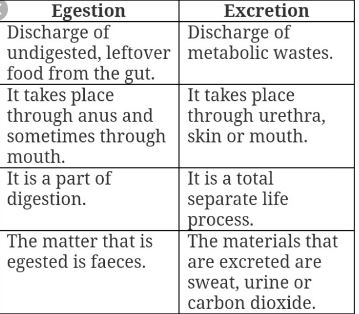What is Difference Between Egestion And Excretion?
Difference Between Egestion And Excretion is that They allow the entry of substances from the outside into the internal environment and the exit of substances in the opposite direction.
The exchange surfaces are digestive absorption, which allows the entry of nutrients; the respiratory, which performs the exchange of gases, and the excretory, which expels waste substances generated by the animal’s metabolic activity abroad.
A) Nutrition stages: A Nutrient and gas collection from the external environment.
B) Digestion.
C) Circulation.
D) Excretion / Salivaaqueous solution composed of water and proteins (ptialine, which hydrolyzes starch and glycogen, and mucin, which lubricates the oral mucosa).
Once the food is crumbled and lubricated, it becomes the bolus. In addition to its digestive function, saliva, by moistening and lubricating the bolus, favors swallowing, protects the oral mucosa and dissolves the particles; In this way, taste buds are stimulated and produce a sensation of taste.
In the stomach, the ingested food is beaten, which culminates in the process of crushing the food. At the same time, it mixes with the secreted juices and acquires a semi-liquid consistency (the chyme forms).
The action of gastric juice is exerted on this nutrient paste, consisting of different types of secretions produced by different types of glandular cells of the gastric mucosa:
• Protective mucin.
• Hydrochloric acid
• Intrinsic factor.
• Enzymes.
Secretions:
• The pancreas pours pancreatic juice into the intestine, which contains digestive enzymes, such as lipases, amylases, and trypsin.
• The liver produces bile, which is stored in the gallbladder and then poured into the intestine. It is an emulsifying agent that combines with fats and disperses them in drops to favor the attack of the other enzymes of the intestine.
• The glands in the intestine wall pour intestinal juice, which contains numerous digestive enzymes; The following stand out – Proteases. After activating each other, these enzymes fully digest the proteins and release free amino acids. – Lipases. Hydrolyze fats, and release glycerin and fatty acids. – Esterases.
They degrade complex lipids, such as cholesterol and its derivatives. – Amylases. They degrade starch and glycogen and release glucose. Sist respi in animals:
Simple diffusion such as porifers or censorereos, Cutaneous respiration (such as annelids and amphibians), Tracheal respiration is typical of terrestrial arthropods.
Gill breathing such as mollusks, crustaceans, fish and many amphibians.
Lung breathing some gastropod mollusks, amphibians, reptiles, birds and mammals. /
Defines: the nutrition process by which energy is obtained to perform vital processes. Four stages: ingestion, digestion, circulation, and excretion.
Ingestion is the uptake of food from the external environment.
EgestionIt is the elimination of waste from food that the body is not able to take advantage of and fails to absorb.
Excretion waste disposal. Difference Between Egestion And Excretion
You May Also Interested:
